#sodor
Text
Leave it to John Oliver for retelling the VERY infamous Thomas the Tank Engine episode (the “Henry’s punishment” episode) as a way to describe America’s current freight train industry!
#hbo#last week tonight with john oliver#last week tonight#john oliver#freight trains#thomas the tank engine#thomas and friends#ttte henry#model trains#sodor#sir topham hatt
388 notes
·
View notes
Text
The Vicarstown Car Ferry

Above: This is not the Vicarstown car ferry train. I just needed a screenshot of a car on a train, and this was the closest I had to hand.
Every year, the Island of Sodor receives thousands of visitors from the Mainland, and obviously, the vast majority come by rail. A significant number, however, choose to arrive by car. Nowadays, this is no trouble, as they can simply drive across the Jubilee Bridge, which carries the main A950 road over the Walney Channel.
The bridge only opened in 1977, though, and any motorists arriving before then had to rely on the NWR's services to get themselves and their cars on and off of Sodor. And thereby hangs a fascinating tale about a little-known aspect of the NWR's history.
EARLY NWR EFFORTS
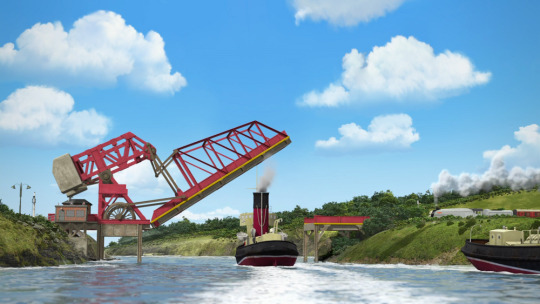
Above: The Vicarstown Bridge, in an undated view (obviously post-1975, given the presence of Spencer).
It all started with the construction of the NWR's own bridge over the Channel in 1915. In those days, there was no other link between Sodor and the Mainland, and thus no other way for goods and passengers to arrive. Some of those passengers wanted to bring their own horse-drawn carriages with them, and so was born one of the earliest vehicle-and-owner trains to run on Sodor.
To begin with, it was simply a case of strapping the vehicle to a special carriage truck, and coupling it up to whatever passenger train its owner was travelling in. The truck then travelled as far as the nearest station to wherever the owner was going, where it was detached and the vehicle rolled off.

Above: For a time, the NWR also offered the use of a horsebox in conjunction with a carriage truck, so that the carriage’s owner could take his own horse with him, and avoid having to search for one at the other end of his journey. This cost extra, though, so there were few takers.
THE VICARSTOWN CAR FERRY
With the boom of private motoring in the early-1920s, there came a similar explosion in demand for the carriage of road vehicles by rail. This in turn resulted in the NWR running its first dedicated car-carrying trains - albeit only on an as-and-when basis, and with cars and drivers travelling in separate trains. The NWR did not return to vehicle-and-owner trains until 1927, when it launched a regular car ferry service between Vicarstown and Barrow-in-Furness - probably the best-known of all its car-carrying trains.
This new service had been made possible by the 1925 LMS Agreement, which gave the NWR running powers into Barrow, and in turn required Vicarstown to be converted for through running. Among the changes which resulted was the conversion of the adjoining goods depot to handle parcels and mail (goods facilities moving to a new depot elsewhere), and the closure of the existing parcels platform. This platform was thus free for conversion into a loading dock for the new car ferry service.
OPERATIONS
Throughout the fifty years the car ferry service ran, the basic pattern of its operation remained much the same, with only details like the motive power, rolling stock and timings seeing much change. It is thus worth looking at a typical journey for the service, starting at Vicarstown and ending at Barrow.
Below: A vague representation of how the loading process would have looked. I've employed a bit of artistic license with this photo: while the NWR did have some enclosed double-decker car carriers, these were never used on the car ferry services.

To begin with, the consist for that particular crossing was shunted into the station - the carriage trucks going to the loading dock, and the passenger coaches to one of the through platforms. Drivers and passengers boarded their coaches, leaving their cars to be loaded by the station staff. Once loading was completed, the carriage trucks were marshalled and coupled to the coaches. All shunting was done by the train engine, who then ran round to the front and hauled the train to Barrow. On arrival, the whole train was shunted to the loading dock there, where passengers and cars were unloaded together. The stock was then taken away for servicing.
Of course, it goes without saying that in the opposite direction, the whole procedure was repeated, only in reverse.
In all, ten car ferry trains ran daily (five in each direction), with provisions in the working timetable for an extra four (two in each direction) if they were needed - say, during the busier summer months. To avoid overcrowding, a maximum of 20 cars were allowed on each crossing, and motorists had to book in advance. This enabled staff to work out how many carriage trucks were required, and what types, well ahead of time. It also allowed them to work out how many passenger coaches were needed - the rule here was that there should be at least one compartment for every car carried.
In the early 1930s, the NWR began allowing larger commercial vehicles to make use of the car ferry trains, and this required a slight amendment to the 20 cars rule. This amendment counted the size of a vehicle in car lengths - if, for example, a lorry turned up which was as long as three cars, then it took up three slots on that particular crossing. Any number of vehicles could thus travel on a single train, so long as their total length did not exceed 20 car lengths.
STOCK
The car ferry trains never had a specific engine allocated to run them - generally, any engine could do the job if they happened to be at Vicarstown or Barrow at the right time. As the NWR’s locomotive roster expanded, the car ferry became the exclusive preserve of the engines based at either of those sheds - the job generally being allocated to any engine who wasn't busy anywhere else that day.
The car ferry was also a neat way of getting an engine from one station to the other, without having to find an extra path for a light engine movement. For similar reasons, it was not uncommon for visiting LMS (later BR) engines to take charge of a Barrow-bound car ferry on their way home.
Below: An example of a long-wheelbase covered carriage truck. Many were later converted for parcels, newspapers or general goods traffic. This particular example went into departmental service, and in this view is carrying engine parts.

As far as rolling stock was concerned, this mainly consisted of both open and covered carriage trucks (henceforth referred to as OCTs and CCTs respectively). When the service first started, cars were carried on short-wheelbase OCTs, but these proved unpopular with motorists, as the cars often had their paintwork spoiled by smoke and soot spewing from passing engines - and sometimes from the engine pulling the train! The NWR tried to remedy this by offering the use of protective tarpaulins, but eventually they decided it would be more prudent to switch to CCTs instead.
Single cars were carried in short-wheelbase vans, similar in design to the GWR’s Mogo vans.
For pairs of cars, longer wheelbase CCTs could be used.
For trios or quartets, bogie CCTs were employed.
When larger commercial vehicles began to be carried, bogie OCTs were used - converted from the underframes of the fabled Dublin Stock.
Because of the aforementioned one compartment for every vehicle rule, the passenger coaches were at first quite a motley collection, with the numbers being made up by any old stock just lying around. It was only from the 1930s onwards that more consistent rakes of coaches began to be used - starting with Ironclad-pattern stock, moving on to Maunsell-pattern just after the War, and finishing up with Bulleid-pattern in the BR era.
MOTORAIL
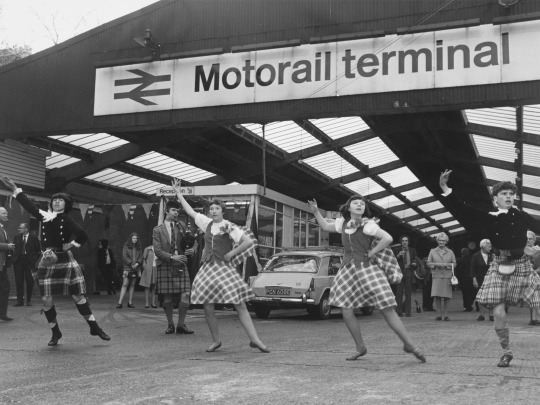
Above: A display of Scottish country dancing at...I think it's Kensington Olympia? No, I don't know why either.
In the 1960s, British Rail officially launched its Motorail service, offering fast travel for passengers and their cars to all parts of the country. To serve Sodor, one of the new services ran twice daily between Kensington Olympia and Vicarstown, and the latter’s existing loading dock was upgraded into a terminal. Two of the car ferry's ten daily crossings clashed with the proposed timings of the new Motorail services, and so were slashed from the timetable. Other than that, the car ferry was able to carry on as normal.
By then, the rolling stock used for the car ferry was beginning to show its age, and a programme of gradual replacement was implemented from about 1966 onwards:
For cars, General Utility Vans replaced the old bogie CCTs, which were retained for parcels traffic.
For commercial vehicles, Carflats replaced the OCTs, which were either scrapped or placed into departmental service.
Finally, for passengers, some of the NWR’s own allocation of BR Mk1s replaced the Bulleid-pattern stock.
The car ferry trains continued unabated into the 1970s, but it was clear they were running on borrowed time - for the first time, demand was beginning to outstrip capacity, and there was no room in the timetable to run extra trains. Then, exactly fifty years after the car ferries had first began, came a blow from which they were never to recover.
THE JUBILEE BRIDGE
That year saw the opening of the Walney Road Bridge, to mark the Silver Jubilee of Queen Elizabeth II. Needless to say, this snuffed out the NWR's car ferry monopoly in an instant. Nobody was more incensed at this development than Sir Topham Hatt, and he saw to it that the NWR was substantially compensated for the extinguishment of their ferry rights.

Above: The Jubilee Bridge. Visitors to Barrow (and native Barrovians, too) may think that this is the only bridge here. This is an illusion!
All was not totally lost, however, for 1977 also saw the extension of BR's existing London-Vicarstown Motorail service to a brand new terminal at Killdane - a more convenient base for the visiting motorist to explore Sodor. Such was the success of this new service that further others were introduced, linking Sodor with other provincial centres. Some of these services employed the stock which had previously worked the car ferry trains.
MODERN DAY MOTORAIL
The expansion of Sodor's Motorail services came during a period of gradual decline for the brand across the rest of BR. The expansion of Britain's motorways, the improvement of car technology, and the chaos of privatisation all ultimately conspired to kill off Motorail by the early-1990s.
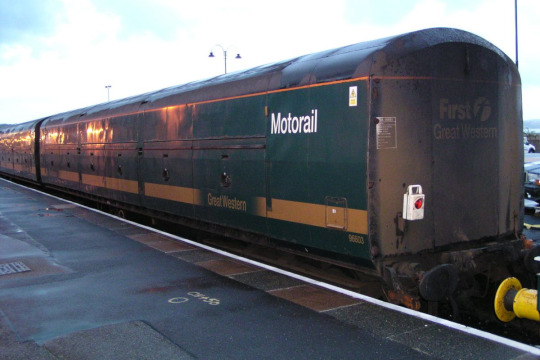
Above: First Great Western briefly revived the Motorail concept in the early-2000s, using a fleet of converted GUVs.
Despite this, Motorail on Sodor has continued to flourish into the present day. Not only are its existing terminals at Vicarstown and Killdane still in operation, but there is now a third terminal at Tidmouth. These form the basis for the NWR's current Motorail services, which all serve to help solve a very basic problem.
The thing is, many visitors to Sodor now arrive in their own cars, but the island's road transport infrastructure isn't really suited to the needs of the long-distance motorist. Fortunately, the NWR has them covered. Special car-carrying trains now run regularly between the Motorail terminals at Vicarstown, Killdane and Tidmouth. While you still have to book in advance, it's a small price to pay for having the convenience of a car at your disposal, without the insanity that comes from having to drive it all the way across Sodor.
Of course, while the NWR's Motorail trains are available to all motorists (local and foreign) the majority of their customers are Mainlanders - the typical Sudrian would just as soon leave his car at home altogether!
#thomas the tank engine#the railway series#sodor#island of sodor#ttte headcanon#ttte analysis#north western railway#vicarstown#vicarstown bridge#barrow in furness#car ferry
42 notes
·
View notes
Text
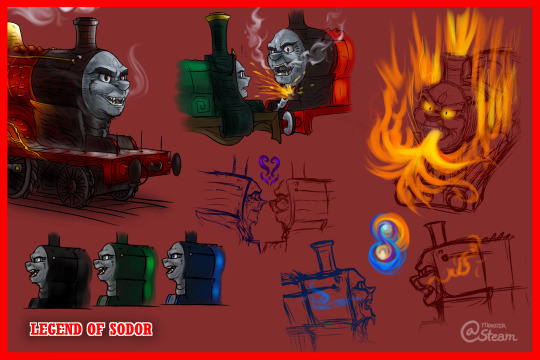
(5/5) HERES JAMES
CW: Stab from a stinger (it’s not blood I swear)
#ttte#thomas and friends#ttte au#ttte fanart#ttte james#james the red engine#james#monster engines#sodor#almost late but fuck it#legend of sodor#ttte edward#edwardtheblueengine#ttte emily#emilythestirlingengine#red hot#favorite character after edward#angy#fire kitty#classical dragon lookin ass#graphical warning
158 notes
·
View notes
Text

'The Gresleys' - WIP
Work in progress- from top to bottom:
Flying Scotsman, his brother Gordon, and young Ryan ^^
#ttte#thomas and friends#thomas the tank engine#ttte gordon#ttte flying scotsman#ttte ryan#island of sodor#sodor#ttte humanized#humanization#steam engines#my art#fan art#digital drawing#wip#work in progress
80 notes
·
View notes
Text

Way back to when James first arrived on Sodor! Before his splendid red uniform… featuring wee lil’ thom and a younger Eddie for the soul
This was a request from a good friend of mine @shelli-gator !!!! Go look at their art!!! Go!!!
#concept art#digital art#illustration#pilot's art!#ttte au#ttte thomas#ttte fanart#ttte james#ttte edward#ttte human#thomas and friends#thomas the train#thomas the tank engine#james#sodor
307 notes
·
View notes
Text
#who is the biggest drama queen#sodor#ttte#james#gordon#ttte james#ttte gordon#thomas the tank engine#thomas and friends#please vote#you choose#survey
33 notes
·
View notes
Text
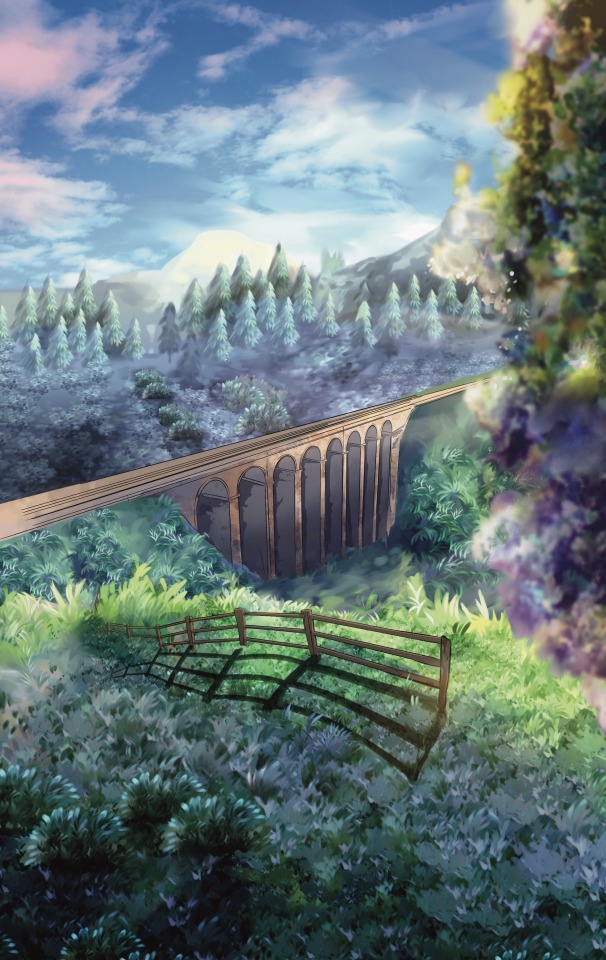
#island of sodor#sodor#thomasandfriends#ttte humanized#thomasthetankengine#thomas and friends#ttte thomas#ttte#thomasthetrain#thomas the train#tttehumanized#thomas the tank engine
96 notes
·
View notes
Text

[1917]
“Goods trains… goods trains…!”
Over the past couple years, Edward had found no shortage of things to complain about on his new railway. Fairly high on that growing list was trucks. They were, he considered, noisy, filthy, and astoundingly bad-tempered. A far cry from the docile, good-natured coaches he usually carried.
“C’mon big blue!” The van behind him shouted. “No wonder they call you a seagull, with how slow you’re moving, it’s like you’re picking crumbs up off the lineside!”
“Pick it up, will ya!” Another truck hollered. “At this rate, it’ll be dark by the time we get there!”
“Shut up!!” Edward barked, his patience waning. “Our pace is fine. You just want me to get into an accident!”
“If we did, maybe then we’d get some excitement.” Another van sulked.
Edward snarled as the consist once again erupted into laughter.
#ttte#thomas and friends#railway series#rws#sodor#island of sodor#ttte edward#ttte troublesome trucks#imagine a time when edward couldn't manage trucks#pre 1920's edward is very fun to think about
39 notes
·
View notes
Text
So How Many Engines Does the NWR Actually Have?
Eighty, according to the Reverend Wilbert Awdry - but this includes British Rail and Industrial engines. It also seems excessive for an island the size of Sodor which has, according to TheUnluckyTug, an 87.7 odd mile mainline and another 30 odd miles of branchline, especially when compared with several other railways of similar size. I am going to warn everyone here, this post is long.
The neighbouring Furness Railway built roughly 247 engines during its lifetime, of which a good fifty-five were 'Sharpies' - however that railway had 190 miles of railway and served some of the largest steelworks and dockyards in all of England. In contrast, the Northern Counties Committee Railway in Northern Island had a maximum route mileage of around 282 miles and only 73 engines. This same NCC ran nearly half of all trains in Northern Island at the time, sharing a duopoly with the GNRI. After amalgamating together into the Northern Ireland Railways and shrinking the full network of Northern Irish railway down to 225 miles, they today run 47 locomotives.
The railway network that serves the entirety of Northern Island is bigger than Sodor in length and requires less engines. It also calls at 54 stations, in comparison to Sodor's 27 stations that the NWR serves. So, let's do some maths and logic puzzles to try and figure out how many engines the NWR actually needs to serve the Island of Sodor.
Firstly, let's look at how many the books name: eleven NWR steam locomotives, six diesel engines, one track maintenance vehicle, as well as three industrial engines and an unknown number of electric engines. This means that the Peel Godred line could have any number of engines, however we can make a reasonable estimate at two multiple units for the four stops, and two or three goods engines to look after the aluminium traffic and other goods work. That makes five engines needed for the branchline.
The Ffarquhar branchline similarly does not require that many engines. Its primary industry is the Anopha Quarry, with a number of farms making up the rest of the freight traffic the line would have. In the books, the line is run by Thomas, Percy, Toby, Daisy and Mavis - the private industrial engine who manages the quarry. This means that there is one dedicated railcar, one autotank-fitted tank engine, a tram engine, a dedicated quarry diesel and Percy to run the line. The only addition possibly required would be an engine to run dedicated stone trains from Ffarquhar to the junction or the harbour, a task that seems to already be covered by Toby, Percy and Mavis. That adds another five engines to our list of standard-gauge engines on Sodor.
Another branchline that does not need any extra engines would be the Little Western, which was only refurbished by Sir Charles Hatt to access the ballast from the old MSR mines. With Duck and Oliver running passengers, Duck managing most of the limited freight traffic that isn't ballast and Donald and Douglas covering most ballast trains, there is no need for any extra engines, and adds another four engines to our list.
After that, Edward's branchline is where we may see some additions. The branchline may be quite short, having only three stations on its route, but it also has Brendam Harbour, which is a major port for the island, as well as the China Clay Pits, which are served by Bill and Ben - the other two industrial engines mentioned in the books. They are known to shunt Brendam Harbour on occasion, while Edward and BoCo run the branchline itself, with Donald and Douglas helping. This line would need more engines as freight traffic through Brendam Docks increased, as well as a dedicated shunting engine for the harbour. That adds up to seven engines to our list to run this section of the line - being Bill, Ben, Edward, BoCo and three new helpers.
Potential candidates from the TVS for filling these roles could be: Salty, Neville, Molly or perhaps Whiff - all of whom are either shunting engines or medium-sized engines who would be able to compliment Edward and BoCo well.
After Edward's branchline, we have to talk about the Kirk Ronan and Norramby branches. The Kirk Ronan branchline has three stations, and was once part of the Sodor and Mainland Railway. We know passenger traffic is poor, and the freight traffic was solely dedicated to mineral traffic from the Skarloey Railway heading to the port. It's highly likely that this line is either kept operational for a token service, or has one engine running it. Either way, we can add one engine to the list, of whom I would suggest Arthur.
The Norramby branchline is currently served by the Other Railway, according to Awdry - this would mean multiple units running passenger trains from Barrow and potentially a freight service, though that would have likely been discontinued in the 1960's during the Beeching cuts. Currently, 26 trains operate out of Barrow up the Cumbrian Coast Line per day, while the Furness line sees roughly 24 trains per day, according to the Northern Rail Timetable. Most likely, one of these two lines would have their services extend to Norramby, meaning up to 24 trains per day for the line. However, it is highly unlikely that each train to arrive on this service is a new engine, with it being more likely to be four or five engines. This adds five engines to our list, for a current total of twenty-seven.
To this figure, we can add the Works Diesel, Bloomer, and the austerity engine referenced in 'Wilbert the Forest Engine', making thirty.
This leaves the mainline as needing 50 whole engines to reach Awdry's figure of 80 - and of this potential number, we know Henry, Gordon, James, Bear, Pip and Emma. To understand how many engines are needed, we need to understand what jobs these engines would do - of which, there is passenger trains, the express, freight trains and shunting.
If the mainline has eleven stations, 87.7 miles of track and they wanted to have a train arrive every hour to meet their Northern partners... well, they'd need more engines. It takes one hour for a train between Lancaster and Barrow - a distance of 28.6 miles, so we can safely assume that tripling the distance would triple the time - for a trip time of around three hours. Now, this time would most likely be shortened by the chance for the engines to achieve higher speeds between stations, as the number of stations on both lines is roughly equal - 10 on the Furness line to 11 on the NWR mainline - but even still, it would require the railway running six separate stopping trains per day. Considering that only four of the six engines above could even run commuter trains, I would say that there is need for more engines.
There are currently two express trains that run on the Island of Sodor: The Limited and the WildNorWester, however it is not certain that the Limited is still running, as it only appeared for 'Enterprising Engines'. In any case, Pip and Emma are enough to handle fast trains on Sodor.
Freight is an interesting variable - we know that Sodor produces aluminium near Peel Godred, and that the alumina needs to be transported up there, and the finished product moved to the mainland, as well as general goods trains, farm produce trains, and freight trains bound for the harbours or from the quarry or China Clay pits. Based on these key requirements, it is safe to say Sodor needs a few more engines.
So, for the mainline we have Pip, Emma, Gordon, Henry, James, Bear and at least eight other engines of various sizes. Two of these engines would be built to run passenger trains alongside Henry, James, Gordon and Bear, while the other six would handle goods traffic, in particular bulk traffic or local goods. Fourteen engines, with potential help from Donald, Douglas and BoCo seems more reasonable as a number of engines on the mainline of a primarily agricultural island.
Suggestions for these engines include Murdoch, Derek, Emily and Rebecca - which is a shorter list than it should be due to the lack of large, mainline engines in the Thomas series who could feasibly run in the UK.
Finally, two shunting engines - one for Tidmouth and one for Barrow-in-Furness - can be added to the list, as since Duck gained his branchline, we have not been introduced to the new station pilot at Tidmouth and since the rise of the multiple-unit, Barrow station would require an engine to act as station pilot there too. Options for here include Diesel, Charlie, Dennis, Rosie and Paxton.
All of these numbers added together equals: 46. Twenty-three branchline engines, three industrial engines, two maintenance engines, one austerity engine, one preserved engine, fourteen mainline engines and two station pilots. Considering at the beginning I said that Northern Ireland Railways runs 47 engines currently and has a network of over double the size of Sodor but doesn't run freight, I would say that this is a pretty respectable estimate.
In direct contrast to this estimate, my ERS has 34 engines who cover the entire NWR and the neighbouring Furness Line. My reasoning: Donald and Douglas are magic, and scarily efficient. Having the two of them around means Edward and BoCo need no help on their branchline, and also Sodor would not need a commuter train every hour - it's a rural, agricultural island with three major population centres at Peel Godred, Vicarstown and Tidmouth. And also cause I have enough characters to balance already, Awdry had the right idea keeping the cast relatively small.
#ao3 stuff#railway series#thomas the tank engine#railways#weirdowithaquill#island of sodor#sodor#very long post#long post#long reads#thomas and friends#brendam branchline#how did maths get into my Thomas and Friends stuff?#rev w awdry#Awdry headcanons#80 engines my foot come on
69 notes
·
View notes
Text
Have you heard the news about Thomas?

No, that's not from the original show, and neither is this:

Some wonderful people over on twitter have spent the last two years (and a lot of money) creating a brand new model Thomas episode (for the first time in 15 years, I might add) using replicas of the original props, camera equipment accurate to the kinds used on the show, an entire sound stage,and more!
Link to the announcement and trailer here
It's premiering on the 26th, in person at the Great Train Show in Edison, NJ and on youtube.
I have had nothing to do with this project btw, I just felt like sharing this around.
#ttte#thomas the tank engine#trains#ttteseries5#season 5#thomas the tank engine season 5#thomas the train#sodor#island of sodor
265 notes
·
View notes
Text

Early in the morning as the railway staff began their duties by looking over the routes and trains they would be pulling for that day.
Unbeknownst to the railway staff though, an imposter was amongst them. Boomer had managed to successfully steal a uniform and infiltrate the staff only area. While the workers were busy with their coffee and morning chatter, Boomer was working to scout out a target for his and Wendell's plan. He read down the list until he came upon the schedule for Percy; an engine without one of the kids with a magic whistle to protect him and an engine that was scheduled to pull a train of Troublesome Trucks, perfect. With a found target, Boomer stealth fully creeped out of the staff room and headed towards the yard.
There Boomer spotted the train of Troublesome Trucks Percy had to take in the next hour. He casually strolled up to the trucks and began to talk to them.
"So, you lot are Sodor's infamous troublesome trucks." Boomer said.
"So what if we are?" Asked one.
"What's it to you"? Replied another.
"Nothing much, just that I think that the trucks on the Mainland were right about you lot." Boomer responded.
"What did they say? What did they say"? The Troublesome Trucks asked in unison.
Boomer tossed away the candy stick in his mouth before answering. It was clear he was there to stir up trouble.
"They said that the troublesome trucks of Sodor we're nothing but a bunch of softies, saying that out of all the time you lot have been here, you've only ever managed to derail only a few engines." Boomer lied.
"How dare they"! One truck roared.
"Softies? Softies! We'll show those mainland trucks who are the real softies"! Roared a Troublesome Truck.
Boomer slipped away as the trucks talked amongst themselves about how to prove they were troublesome.
By then Percy arrived. He could hear the trucks talking to each other, but couldn't hear what they were saying as he backed up to be coupled to the train.
"Boy you trucks are sure chatty today, what has gotten all of you rowdy "? Percy asked.
The trucks immediately hushed up. They looked back at each other than began to giggle quietly to themselves, they had come up with a devious idea.
"Uh, the rails, they..." One addressed Percy.
" They make a funny squeaking sound if you ride on them while olive oil is spilled over them." A truck made up.
"Oh, that would be funny. Now, come along, we can't be late with our goods." Percy said, unaware of the trucks plan.
Percy was on his way to Fenland Junction and began to approach the double hills. Percy kept his attention on the trucks as he knew they had a tendency to try and hold an engine back while climbing the hills and for pushing them when going down hill.
They made it to the top of the hill with no issue, but Percy and his crew knew they weren't out of the woods just yet as they began the decline.
"Those trucks are up to something." Percy's firewoman said, but the driver hadn't paid any mind as they were focused on preparing Percy's brakes to prevent the small green engine from rolling down the hill uncontrollably. However, as the driver was about to pull the brakes, the trucks enacted their plan.
"Now! On! On! On"! A truck cried out.
The Troublesome Trucks gave Percy a powerful bump, causing his driver to fall out before they could apply the brakes, causing Percy to thunder down the hill.
"Help"! Percy cried out as the cargo inside the trucks began to shift to one side.
"Tilt, tilt, tilt"! The trucks sang.
Percy could feel himself leaning over, the train and him were going to derail! His firewoman tried her best to prevent the tip over, but there wasn't much she could do.
Just as Percy was coming off the rails, something reached out and wrapped around Percy. The force tugged at the small engine, pulling him back onto the track. The mysterious force did not let go as it aided in helping Percy come to a safe hault.
Percy could hear his rescuer panting as the ordeal came to an end.
"Huff...Huff. By Noah's Arc that was close"! Said a figure.
Percy looked over and gasped in surprise. Cleo's stories echoing in his smokebox.
"Wendell"?!
#ttte#thomas the tank engine#thomas and friends#sodor#oc#ttte oc#ttte percy#percy the green engine#percy the small engine
18 notes
·
View notes
Text
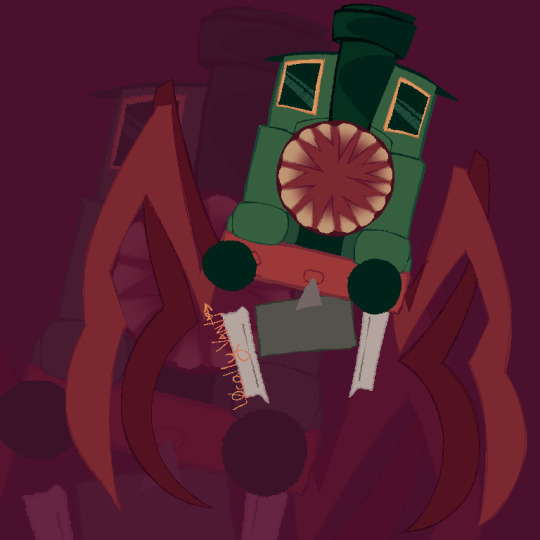
Guys look it's The B[r]east
All seriousness though I like the way this creature came out [Once again I was drawing on my really laggy tablet please save me🫡]
Babygirl character /j
#thomas and friends#thomas the tank engine#ttte#the railway series#sodor#island of sodor#sodor fallout#thomas the train#artists on tumblr#art#digital art
41 notes
·
View notes
Text
Traintober-lite
Hi guys, just dropping in to say that , no I'm not dead or anything. I've merely caught a major case of capitalism with a side of adult, so I've been working a lot.
With that in mind, let's get into why I am here:
As you might have seen @theflyingkipper has taken on this year's Traintober duties, and I imagine it's going to be a blast. However if you're like me and have (checks watch) negative time to devote to a month of train content, then I have the solution for you! Just one Halloween themed TTTE prompt/challenge, which you can devote as much, or as little, time to as you want.
And that prompt is:
Sodor's Ghostwatch
To explain what this is, we have to go down a bit of a British TV history rabbit hole:
On Halloween night, 1992, the BBC aired Ghostwatch , an hour and a half long programme that purported itself to be a live TV investigation into a haunted house in London. The poltergeist, named "Mr. Pipes", or just "Pipes", is tormenting a family by possessing their daughter on a regular basis. I'll spare the specifics for brevity's sake, but while the broadcast starts off normal, it gradually becomes clear that Pipes is using the broadcast as a way to transmit himself across the TV airwaves, eventually kidnapping the presenter in the house, and jumping into the broadcast studio to possess Michael Parkinson as the broadcast ends.
Now, if that name rung a bell with you, well done. Michael Parkinson was a very famous BBC talk show host... as was every other on-screen personality on the show. That was on purpose, because while the show was actually scripted, it was intended to give the appearance of being a live broadcast, using real TV personalities, real TV facilities, and during a real timeslot on BBC 1, the flagship TV station for the country, at a time when satellite TV and alternative cable channels numbered in the low double digits.
Let me rephrase this: The BBC, an organization that does not joke around, created their own version of the War of the Worlds broadcast, except that instead of aliens invading, they told the entire country that they were doing a live show about a real haunting... and then the ghost escaped and attacked the presenters.
The BBC got over thirty thousand phone calls before the end of the night. Michael Parkinson's mother was one of the callers. Numerous people who believed that the show was legit had actual problems afterwards, ranging from the absurd (a woman called the BBC demanding they pay her husband's laundry bill after he soiled himself while watching) to the more upsetting. (lots of children got nightmares)
To this day the special has never aired again on British TV, regardless of network, and it likely never will again. It predated, and inspired, films like Derren Brown's Séance, The Blair Witch Project, and Host (2020).
It is one of the greatest TV events of its time. It scared the shit out of a lot of people.
So... with that in mind,
What do we think happened on Sodor?
That's what this challenge is:
By 9:00 PM GMT on 31 October, 2023 (5:00 PM US EST), produce some content about Ghostwatch and its effect on Sodor and its residents. It can be art, a story, an audio file, whatever. This is a very freeform challenge. You can make one thing or you can make twenty, just make sure that they're good. Nothing else really matters. Tag it with #Sodor's Ghostwatch and see what everyone else has made!
#sodor#ttte#ttte headcanon#this is ttte#Sodor's Ghostwatch#ghostwatch#traintober#traintober 2023#traintober2023
50 notes
·
View notes
Photo


It's 5/5 so heres James. Nothing new for him, so have the updated RWS fleet shot as well.
#ttte james#RWS#ttte#ttte thomas#ttte edward#ttte henry#TTTE Gordon#ttte percy#ttte toby#ttte duck#ttte donald#ttte douglas#ttte emily#Jame's Day#splendid red#North Western Railway#NWR#sodor#island of sodor
71 notes
·
View notes
Text

"The nightmares still haunt me"
Ryan never forgets the foul treatment he battled through before coming to Sodor, often neglected and overworked. His outer scars have now healed...but he will always carry the scars from the past, deep within him...
#ttte#thomas and friends#thomas the tank engine#ttte ryan#ryan the purple tank engine#gnr#island of sodor#sodor#my art#fan art#steam engines#steam locomotive#au#digital sketch#sketch
79 notes
·
View notes
Text
The Boulder Quarry Line
I recently binged the entire Classic Series again, as background noise while I was working on something else. When I got to Series 5-7, I remembered a headcanon I’d developed ages ago, to link together most of the Skarloey Railway episodes from those seasons. This recent binge spurred me to finally write it down, and bash it into something a little more coherent. Most of this is just me thinking aloud, but I thought I'd run it up the flagpole and see who salutes it...
1951
Just as operations are winding down at the old slate quarry at Ward Fell, new beds of good-quality slate are discovered in the hills north of Rheneas. A new quarry is established to extract this slate, and this helps to revive the Skarloey Railway’s then-declining fortunes. Even so, the surveyors who uncovered this slate are convinced there are still further treasures to be found deeper into the mountains.

1950s-60s
The search for such treasures is carried out as time allows - which isn’t very often, considering all the new developments which take place on the SR during this time.
Roughly 1970
Finally, a discovery is made - large deposits of stone in the northern foothills of Shane Dooiney, of similar quality to that quarried at Ffarquhar. Plans are quickly devised to extract the stone, and the Skarloey Railway is tasked with building a line to the new quarry.
The proposed line branches off the Rheneas Quarry line, passes through a natural ravine known locally as Echo Pass, travels alongside the main Skarloey-Peel Godred road, and finally turns south towards the new quarry site.
1970-early 1972
The line is constructed, following the route described above. When it is completed, trains start carrying building supplies to the site of the new quarry. Some trains are also laid on for the benefit of a road-building company, which is upgrading the Skarloey-Peel Godred road so that heavier vehicles can access the quarry as well.
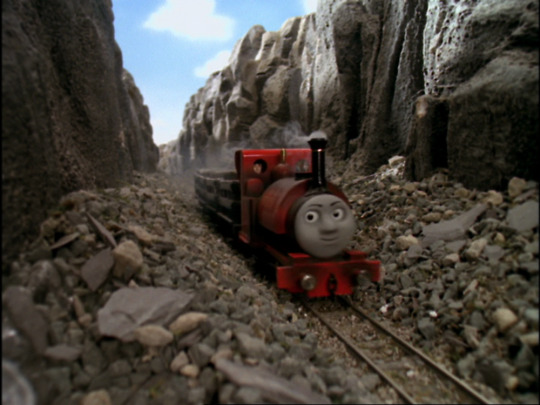
Winter 1972
Due to a problem with the winch, some trucks break away on the incline at Rheneas Quarry. The breakaway tumbles into Echo Pass, triggering an avalanche which buries Skarloey, who happened to be travelling through the Pass with a supply train. He is subsequently rescued by Rusty.
These events are later loosely adapted into the episode Snow.
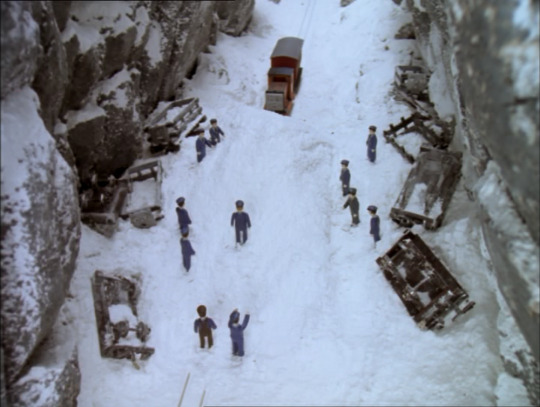
Early 1973
The new quarry finally opens for business, and even has a new name - Boulder Quarry, after an enormous, spherical boulder which looms ominously over part of the line. Boulder Quarry enjoys a prosperous first few months, and the Skarloey Railway enjoys the revenue boost provided by the new stone traffic.
After a while, Rusty begins to feel nervous about the Boulder, but can’t really explain why. The others don’t take him too seriously.

Autumn 1973
After several weeks of heavy rain, Boulder Quarry is able to try out its latest acquisition - an experimental drilling machine known as Thumper. Unfortunately, the vibrations from Thumper cause the Boulder to fall off its perch, and run away down the Skarloey Valley. The Boulder causes a great deal of damage to track and property all down the valley, culminating in the destruction of some new stone-cutting sheds just outside Crovan’s Gate.
All concerned parties agree the disaster is an act of god telling them to leave that part of Sodor alone, and Boulder Quarry shuts its doors for good - financially crippled by having been forced to pay substantial compensation to every property owner in the valley.
The Skarloey Railway also ends up in dire straits - besides the damage caused by the Boulder, several years of hard work have just gone down the tubes.
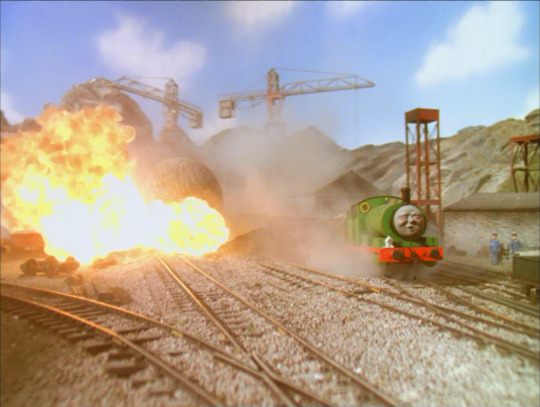
The remainder of 1973
The Thin Controller decides to temporarily close the SR, so that everyone can focus their efforts on repairing all the damage to track and property. The rest of 1973 is spent doing just that.
The events of Duncan Gets Spooked take place during this clean-up operation.
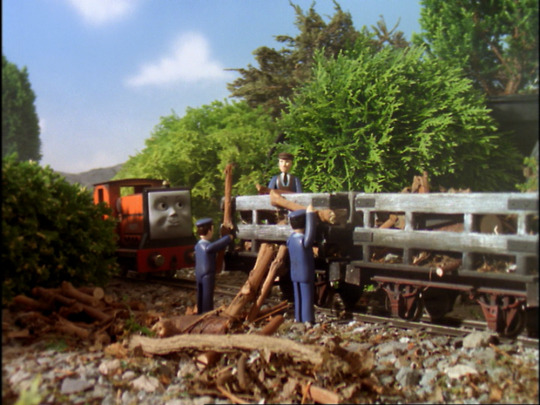
At some point, the time is found to move the Boulder to a new, safer perch - on a specially-constructed plinth on a hill near to Crovan’s Gate, and positioned to face in the direction of its old perch.
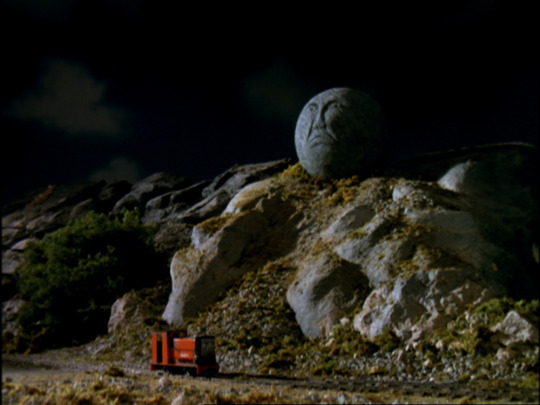
That winter, during a break, the little engines tell Thomas (or more likely some other standard gauge engine) the story of Skarloey’s Avalanche.
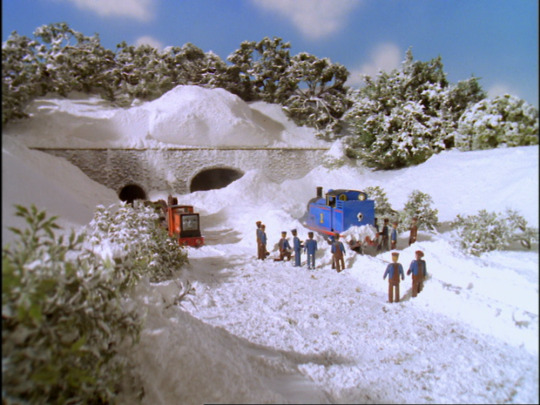
1974
The clean-up continues into 1974, and the line remains closed for the first half of that year. The Thin Controller hopes to have the line ready to reopen in time for the start of the summer operating season. Fortunately, Rheneas Quarry is closed for the two weeks before, freeing up men and engines to help. Elizabeth also happens to be working in the area, and is persuaded to lend a wheel. With all this help, the clean-up is completed in the nick of time, and the Skarloey Railway is officially declared open once more.

Meanwhile, the people of Glennock decide to treat themselves to a new organ for the village school. Headmaster Hastings personally oversees the delivery of the organ. This isn’t really relevant to the Boulder saga - I just felt like mentioning it.

1975
By this year ,things are more or less back to normal on the Skarloey Railway. One day, Rheneas takes a special charter train carrying a party of schoolchildren from the Mainland. On his way back down the line, he is accidentally diverted onto the abandoned line to Boulder Quarry. The line isn’t in the best condition, and wasn’t designed to carry passengers anyway, so Rheneas has a real rollercoaster ride to the Quarry and back.
Since the children enjoyed themselves so much, the Thin Controller lets Rheneas off for his mishap, but it gets him thinking about the old line, and how he might be able to get his money’s worth from it after all…

Surveys are carried out, and it is decided to reopen the old quarry line to serve as a connection between the SR and the Culdee Fell Railway - the latter being reached by rerouting the line in the direction of their station at Skarloey Road.

The line also passes through many areas of natural beauty, and so a number of stations are proposed to serve some of these areas. These stations include Elephant Park (above) and Rumblin Bridge (below).
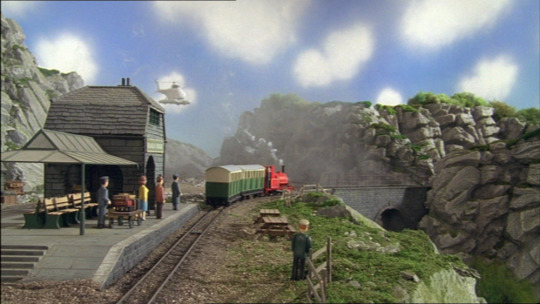
The terminus of the line is at the village of Skarloey Road. So as to avoid confusion with the CFR station, the SR station is known as Upland Station. While not a direct link between the two railways, their respective stations are still a reasonably short walk away from each other.
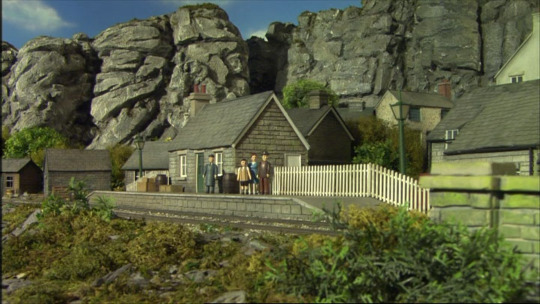
The reconstruction of the line takes place throughout the first half of 1975, and is completed just in time for the summer operating season. Sir Topham Hatt and Lady Hatt attend the grand opening, having first viewed the new line from a hot air balloon (and then made a crash-landing in said balloon).
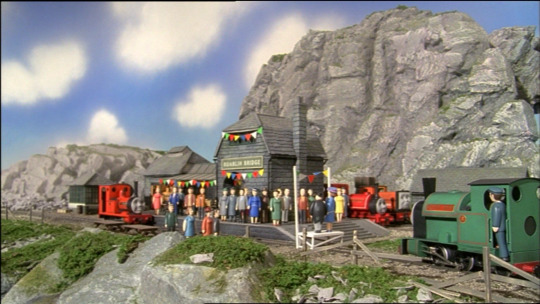
To finish off, here is a rough map of the original Boulder Quarry line, the subsequent Upland Extension, and how they both relate to the main SR line.
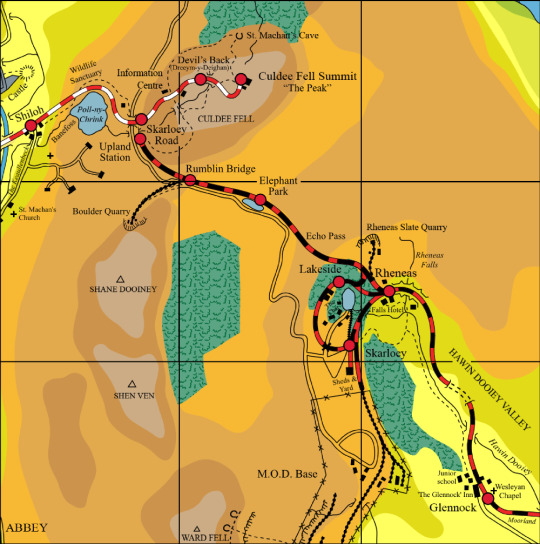
#thomas the tank engine#the railway series#sodor#island of sodor#skarloey railway#ttte headcanon#ttte boulder#sir topham hatt#the fat controller#lady hatt#the thin controller#mr percival
26 notes
·
View notes